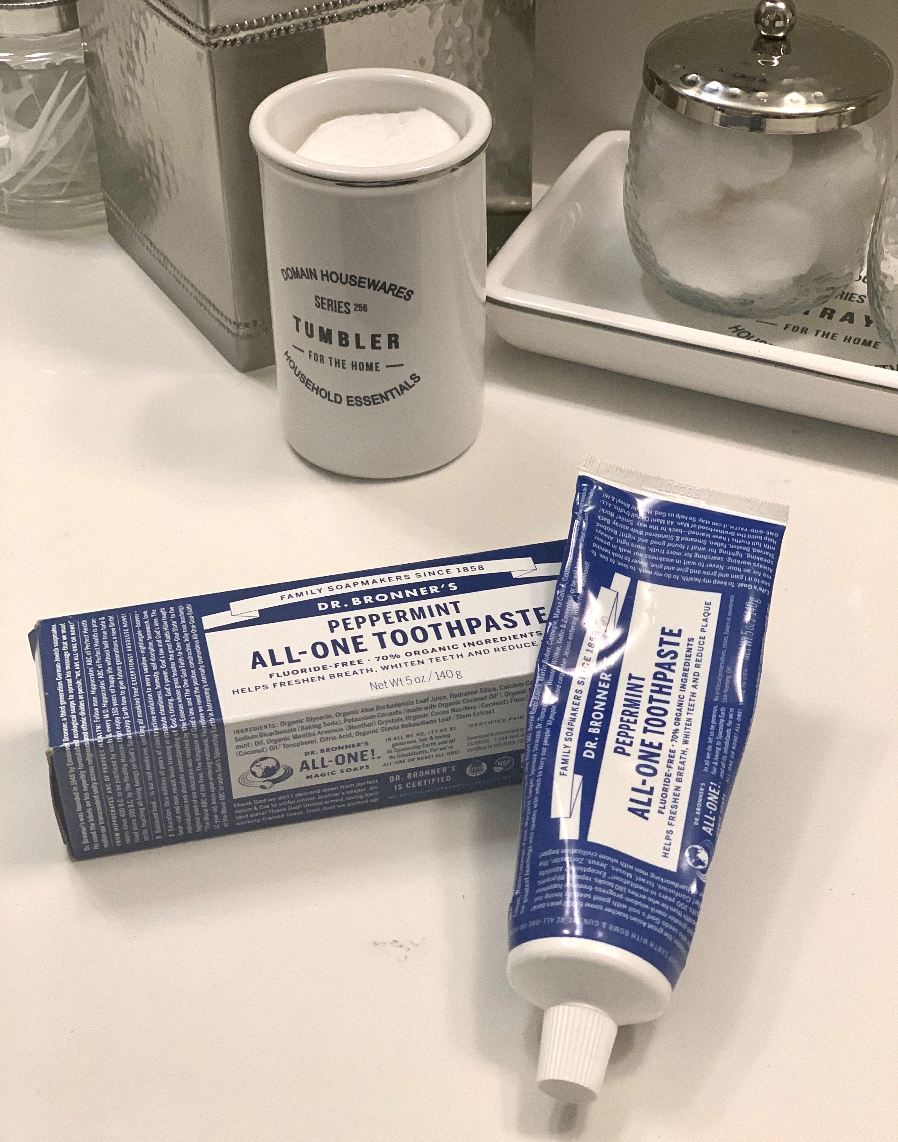Toothpastes can have some of the most questionable ingredients of any product, and you definitely swallow and ingest at least some of your toothpaste twice a day every day—assuming you brush your teeth as advised by your dentist. So, it’s best if you use a nontoxic toothpaste when brushing your teeth.
Some of the toxic ingredients in those typical toothpastes you see at the grocery store or stores like Target, are natural flavors, diethanolamine, sodium lauryl sulfate, polyethylene glycols, triclosan, parabens, artificial colors and sweeteners, carrageenan, and fluoride. Some of the “so called” natural toothpastes still suck. To digress for a second the term “natural” doesn’t really mean anything. It is a way for companies to make it seem like they are on the up and up when they’re not. It’s like when you see chicken that is labeled natural. That doesn’t mean anything. Antibiotic free, pasture raised, organic and grass fed all mean something. Natural is a façade. It doesn’t indicate that you are buying something nontoxic or clean. The companies think you are dumb and are trying to trick you.
Okay, back to discussing toothpaste.
The toxic chemicals in toothpastes can literally hurt you. Diethanolamine helps to create foam in toothpastes; it’s also used in the crap, toxic household cleaning products. It’s been banned in the European Union in products like toothpaste and is associated with hormone-disruption, cancer and organ toxicity. The European Union actually has standards, so they are a good comparison to look at when deciding what is okay to use and what is problematic to use. Sodium lauryl sulfate is similar to diethanolamine; it’s a detergent used to make products foam and is associated with skin irritation, allergies and toxicity to aquatic life. It has been shown to cause gingival irritation and increased occurrence of aphthous ulcers, and fluoride can be toxic in large quantities. I would say that ingesting littles bits of fluoride over and over again, day in and day out, can build over to a large quantity. Polyethylene glycols are petroleum-based compounds used in toothpastes to help keep ingredients stable and enhance the penetration of other active ingredients. These glycols are associated with the carcinogenic contaminant 1,4-dioxane which can cause cancer, liver damage, and/or kidney damage. Triclosan is an antimicrobial agent that is used to fight plaque and gingivitis; this one can cause liver damage, cancer and endocrine disruption. Parabens are preservatives added to toothpastes to stop fungus and bacteria from growing in them, and parabens like the other chemicals are linked to cancer, endocrine disruption, reproductive toxicity, neurotoxicity and skin irritation. Carrageenan is apparently extracted from a natural source, but it is extremely harmful to the digestive system. It causes an immune system response, which causes inflammation. A lot of toothpastes also have artificial coloring and dyes—especially those kid’s toothpastes that are all red, pink, blue and glittery. The dyes used in toothpaste come from petroleum and coal tar, which can build up in the body overtime to create organ system toxicity. If you start seeing abbreviations with a color next to it, you know you are looking at some artificial dyes, and it’s best to just toss that product out.
There are a few following ingredients in toothpaste that are problematic to some but also debated by others. I believe these ingredients are really a problem and avoid them in my toothpaste and really everything I buy. These are natural flavors and fluoride. Natural flavors are a catchall that sounds like it’s okay and “natural”, but it’s not. It is a term that hides a lot of terrible ingredients that are harmful to you. The term natural flavor or natural flavoring means “the essential oil, oleoresin, essence or extractive, protein hydrolysate, distillate, or any product of roasting, heating or enzymolysis, which contains the flavoring constituents derived from a spice, fruit or fruit juice, vegetable or vegetable juice, edible yeast, herb, bark, bud, root, leaf or similar plant material, meat, seafood, poultry, eggs, dairy products, or fermentation products thereof, whose significant function in food is flavoring rather than nutritional.” It could literally be anything, and I don’t really like ingesting things that I do not really know what they are.
Lastly, fluoride, in my opinion, is extremely toxic, and it is not needed to have good dental hygiene. There apparently are no statistically significant differences in teeth of those people who use fluoride toothpaste and those who do not, but using fluoride can cause irritation, organ system toxicity and neurotoxicity. Fluoride is specifically toxic when ingested, inhaled and in contact with your skin. As previously noted, you definitely ingest some toothpaste when you are brushing, so that is problematic. You are definitely ingesting fluoride. The following are a few side effects of consuming fluoride: (i) acute poisoning, (ii) birth defects, (iii) osteoarthritis, (iv) bone & uterine cancer, (v) perinatal death, (vi) immune system suppression, (vii) gastrointestinal disorders, (viii) essential enzyme inhibition and (ix) skeletal fluorosis (leading to brittle teeth and bones). For me, it’s not worth the risk—especially when statistics do not really show a real benefit to using it.

I think the biggest lesson is to read the ingredient labels of your toothpaste and decide what you are willing or not willing to accept. After looking into all of this and comparing the different toothpaste brands, I have settled on Dr. Bronner’s All-One Toothpaste. Seventy percent (70%) of the ingredients are organic, it does not include synthetic detergents and does not have natural flavors, so it works for me. And, if I want to add a little bit of an extra whitening component to the toothpaste, I mix some of my toothpaste with my activated charcoal capsules and brush my teeth like that. Here’s to keeping our teeth a little more well preserved.
Always,
Taylor




